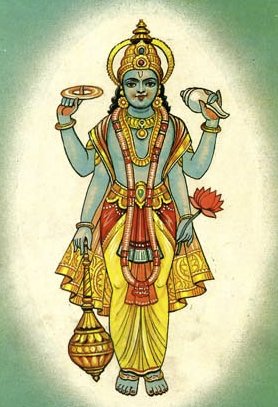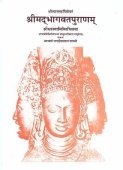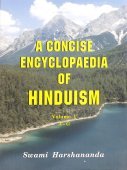Gokula, Go-kula: 21 definitions
Introduction:
Gokula means something in Hinduism, Sanskrit, Buddhism, Pali, the history of ancient India, Marathi. If you want to know the exact meaning, history, etymology or English translation of this term then check out the descriptions on this page. Add your comment or reference to a book if you want to contribute to this summary article.
In Hinduism
Purana and Itihasa (epic history)
Source: Cologne Digital Sanskrit Dictionaries: The Purana IndexGokula (गोकुल).—See Vraja.*
- * Bhāgavata-purāṇa II. 7. 31; Viṣṇu-purāṇa V. 1. 74; 5. 7; 11. 13.
Gokula (गोकुल) is a name mentioned in the Mahābhārata (cf. VIII.4.38) and represents one of the many proper names used for people and places. Note: The Mahābhārata (mentioning Gokula) is a Sanskrit epic poem consisting of 100,000 ślokas (metrical verses) and is over 2000 years old.

The Purana (पुराण, purāṇas) refers to Sanskrit literature preserving ancient India’s vast cultural history, including historical legends, religious ceremonies, various arts and sciences. The eighteen mahapuranas total over 400,000 shlokas (metrical couplets) and date to at least several centuries BCE.
Vaishnavism (Vaishava dharma)
Source: Devotees Vaishnavas: Śrī Garga SaṃhitāGokula (गोकुल) refers to place north of Nandanagara according to the Garga-saṃhitā 2.17.31. Accordingly, “Śrī-Bhagavān said: O girl whose thighs are graceful as banana trees, I live in Gokula, just north of Nanda’s palace in Nandanagara. My name is Gopadevatā”.
Source: Acta Orientalia vol. 74 (2013): Historical sequence of the Vaiṣṇava DivyadeśasGokula (Āyppāṭi) refers to one of the 108 Vaishnava Divya Desam (divyadeśas or divyasthalas), located in the topographical division of Vaṭanāṭu (“North India”), according to the 9th century Nālāyirativviyappirapantam (shortly Nālāyiram).—Tradition would record the Vaiṣṇava divyadeśas or divyasthalas are 108. The divyadeśa is a base of the cult of Viṣṇu in Viṣṇuism [Vaiṣṇavism] tradition. The list of 108 [viz., Gokula] seems to have reached maturation by about the early 9th century CE as all the deśas are extolled in the hymns of the twelve Āḻvārs.
Source: Pure Bhakti: Brhad BhagavatamrtamGokula (गोकुल) refers to:—The aspect of Vṛndāvana situated in the highest realm of the spiritual world; the abode where Śrī Kṛṣṇa manifests His original and topmost feature as a cowherd boy, surrounded by His intimate and loving servitors, the gopas and gopīs of Vraja. (cf. Glossary page from Śrī Bṛhad-bhāgavatāmṛta).

Vaishnava (वैष्णव, vaiṣṇava) or vaishnavism (vaiṣṇavism) represents a tradition of Hinduism worshipping Vishnu as the supreme Lord. Similar to the Shaktism and Shaivism traditions, Vaishnavism also developed as an individual movement, famous for its exposition of the dashavatara (‘ten avatars of Vishnu’).
Shaivism (Shaiva philosophy)
Source: SOAS University of London: Protective Rites in the Netra TantraGokula (गोकुल) refers to the “cow-herd”, according to the Netratantra of Kṣemarāja: a Śaiva text from the 9th century in which Śiva (Bhairava) teaches Pārvatī topics such as metaphysics, cosmology, and soteriology.—Accordingly, [verse 19.117-120, while describing the protection of the kingdom’s animals]—“The Mantrin should honor [Amṛteśa] in the middle of the cows, from this the herd should increase (gokula—vardheta gokulam). He applies vermillion or red chalk infused with the mantra to the tips of the horns of the cow for [their] protection. He should perform the same rite to protect the horses. After he infuses the water jug with the mantra, he should pour it over their heads. [...]”.

Shaiva (शैव, śaiva) or Shaivism (śaivism) represents a tradition of Hinduism worshiping Shiva as the supreme being. Closely related to Shaktism, Shaiva literature includes a range of scriptures, including Tantras, while the root of this tradition may be traced back to the ancient Vedas.
India history and geography
Source: Cologne Digital Sanskrit Dictionaries: Indian Epigraphical GlossaryGokula.—(EI 9), cf. ‘officer in charge of the gokulas’; cf. Gokul-ādhikārin, Gokulika, Gomaṇḍalika. (SITI), a temple of Kṛṣṇa; also called āyappāḍi in Tamil. Note: gokula is defined in the “Indian epigraphical glossary” as it can be found on ancient inscriptions commonly written in Sanskrit, Prakrit or Dravidian languages.

The history of India traces the identification of countries, villages, towns and other regions of India, as well as mythology, zoology, royal dynasties, rulers, tribes, local festivities and traditions and regional languages. Ancient India enjoyed religious freedom and encourages the path of Dharma, a concept common to Buddhism, Hinduism, and Jainism.
Languages of India and abroad
Pali-English dictionary
Source: BuddhaSasana: Concise Pali-English Dictionarygokula : (nt.) a cow-shed.

Pali is the language of the Tipiṭaka, which is the sacred canon of Theravāda Buddhism and contains much of the Buddha’s speech. Closeley related to Sanskrit, both languages are used interchangeably between religions.
Marathi-English dictionary
Source: DDSA: The Molesworth Marathi and English Dictionarygōkula (गोकुल).—n (S) pop. gōkūḷa n The name of the village at which kṛṣṇa was brought up. 2 The mud figures (of men, walls, cattle &c. in representation of the village) made on the eighth of śrāvaṇa. 3 fig. Promiscuous and licentious intercourse. v māja. gōkuḷānta yēṇēṃ (To enter into gōkūḷa, i. e. the infinite and omnipresent Deity as incarnate in kṛṣṇa to be comprehended within the limits of gōkūḷa) To be contracted or reduced into little--life, riches &c.: also to come within manageable or convenient compass or dimensions--a business.
Source: DDSA: The Aryabhusan school dictionary, Marathi-Englishgōkula (गोकुल).—n The town where kṛṣṇa was brought up. Promiscuous and licentious intercourse.
--- OR ---
gōkūḷa (गोकूळ).—n The town where kṛṣṇa was brought up. Promiscuous and licentious intercourse.
Marathi is an Indo-European language having over 70 million native speakers people in (predominantly) Maharashtra India. Marathi, like many other Indo-Aryan languages, evolved from early forms of Prakrit, which itself is a subset of Sanskrit, one of the most ancient languages of the world.
Sanskrit dictionary
Source: DDSA: The practical Sanskrit-English dictionaryGokula (गोकुल).—
1) a herd of kine; वृष्टिव्याकुलगोकुलावनरसादुद्धृत्य गोवर्धनम् (vṛṣṭivyākulagokulāvanarasāduddhṛtya govardhanam) Gītagovinda 4; गोकुलस्य तृषा- र्तस्य (gokulasya tṛṣā- rtasya) Mb.
2) a cow-house.
3) Name of a village (where Kṛṣṇa was brought up).
Derivable forms: gokulam (गोकुलम्).
Gokula is a Sanskrit compound consisting of the terms go and kula (कुल).
Source: Cologne Digital Sanskrit Dictionaries: Shabda-Sagara Sanskrit-English DictionaryGokula (गोकुल).—n.
(-laṃ) 1. A herd of kine, a multitude of cattle. 2. A cow-house or station. 3. A village or tract on the Jumna, the residence of Nanda and of Krishna during his youth. n. go a cow, and kula an assemblage.
Source: Cologne Digital Sanskrit Dictionaries: Benfey Sanskrit-English DictionaryGokula (गोकुल).—n. 1. a herd of kine, [Rāmāyaṇa] 1, 9, 60. 2. the name of a temple, [Rājataraṅgiṇī] 5, 23.
Gokula is a Sanskrit compound consisting of the terms go and kula (कुल).
Source: Cologne Digital Sanskrit Dictionaries: Cappeller Sanskrit-English DictionaryGokula (गोकुल).—[neuter] herd or station of cattle.
Source: Cologne Digital Sanskrit Dictionaries: Aufrecht Catalogus CatalogorumGokula (गोकुल) as mentioned in Aufrecht’s Catalogus Catalogorum:—See Utprekṣāvallabha.
Source: Cologne Digital Sanskrit Dictionaries: Monier-Williams Sanskrit-English Dictionary1) Gokula (गोकुल):—[=go-kula] [from go] n. a herd of kine, [Mahābhārata; Rāmāyaṇa] etc.
2) [v.s. ...] a cow-house or station, [ib.]
3) [v.s. ...] a village or tract on the Yamunā (residence of Nanda and of Kṛṣṇa during his youth, [Bhāgavata-purāṇa; Religious Thought and Life in India p.113] the inhabitants of that place), [Bhāgavata-purāṇa ii, 7, 31]
4) [v.s. ...] Name of a certain sanctuary or holy place, [Rājataraṅgiṇī v, 23]
Source: Cologne Digital Sanskrit Dictionaries: Yates Sanskrit-English DictionaryGokula (गोकुल):—[go-kula] (laṃ) 1. n. A herd of kine; a cow-house; place on the Jumna.
[Sanskrit to German]
Sanskrit, also spelled संस्कृतम् (saṃskṛtam), is an ancient language of India commonly seen as the grandmother of the Indo-European language family (even English!). Closely allied with Prakrit and Pali, Sanskrit is more exhaustive in both grammar and terms and has the most extensive collection of literature in the world, greatly surpassing its sister-languages Greek and Latin.
Kannada-English dictionary
Source: Alar: Kannada-English corpusGōkula (ಗೋಕುಲ):—
1) [noun] a number of cattle living or being driven together; a herd.
2) [noun] a building, shed for cattle.
3) [noun] a series of lines or rays coming to or spreading out from a point; a pencil of rays.
--- OR ---
Gōkuḷa (ಗೋಕುಳ):—[noun] = ಗೋಕುಲ [gokula].
Kannada is a Dravidian language (as opposed to the Indo-European language family) mainly spoken in the southwestern region of India.
Nepali dictionary
Source: unoes: Nepali-English DictionaryGokula (गोकुल):—n. 1. a flock of crows; 2. a place of pilgrimage in north India at the bank of Yamuna river; 3. a golden earring;
Nepali is the primary language of the Nepalese people counting almost 20 million native speakers. The country of Nepal is situated in the Himalaya mountain range to the north of India.
See also (Relevant definitions)
Starts with: Gokula bhatta, Gokulacandra, Gokuladeva, Gokulajit, Gokulakirna, Gokulanatha, Gokularatna bhatta, Gokulashtaka, Gokulashtami, Gokulashtamipuja, Gokulashtamivrata, Gokulastha, Gokulasthashraddhapaddhati.
Ends with: Nandacem Gokula, Nandacem-gokula, Nandagokula, Sa-gokula.
Full-text (+88): Gokulesha, Vrindavana, Gokulastha, Gokulajit, Gokulanatha, Gokulashtaka, Nandacem-gokula, Kokulashtami, Nandacem Gokula, Gokulodbhava, Nandavraja, Govinda, Kandushala, Sa-gokula, Shambhurama, Nandanagara, Gokula bhatta, Utprekshavallabha, Caudhalanem, Sundarishataka.
Relevant text
Search found 43 books and stories containing Gokula, Go-kula, Gōkula, Gōkūḷa, Gokūla, Gōkuḷa; (plurals include: Gokulas, kulas, Gōkulas, Gōkūḷas, Gokūlas, Gōkuḷas). You can also click to the full overview containing English textual excerpts. Below are direct links for the most relevant articles:
Garga Samhita (English) (by Danavir Goswami)
Verse 3.2.13 < [Chapter 2 - The Great Festival of Śrī Girirāja]
Verse 4.13.3 < [Chapter 13 - The Story of the Demigoddesses]
Verse 5.19.4 < [Chapter 19 - The Festival on Śrī Kṛṣṇa Return]
Bhakti-rasamrta-sindhu (by Śrīla Rūpa Gosvāmī)
Verse 2.3.48 < [Part 3 - Involuntary Ecstatic Expressions (sattvika-bhāva)]
Verse 4.6.7 < [Part 5 - Dread (bhayānaka-rasa)]
Verse 4.9.42 < [Part 9 - Incomplete Expression of Mellows (rasābhāsa)]
The Bhagavata Purana (by G. V. Tagare)
Chapter 27 - Indra coronates Kṛṣṇa < [Book 10 - Tenth Skandha]
Chapter 25 - Lifting up of Mount Govardhana < [Book 10 - Tenth Skandha]
Chapter 5 - Celebration of Kṛṣṇa’s Birth: Meeting of Nanda and Vasudeva < [Book 10 - Tenth Skandha]
Srila Gurudeva (The Supreme Treasure) (by Swami Bhaktivedanta Madhava Maharaja)
Śrīmatī Rādhikā is Always Absorbed in Pleasing Kṛṣṇa < [Chapter 2.4 - The Uttamā Bhāgavata and Kṛpa-Pātra]
Talking with the Learned Scholar Vaṃśaropaṇa Siṃha < [Chapter 1.5 - Back to Home Village]
Difference between Aiśvarya and Mādhurya < [Chapter 2.12 - Early ISKCON Conversations with Śrīla Gurudeva]
Chaitanya Bhagavata (by Bhumipati Dāsa)
Verse 2.24.20 < [Chapter 24 - The Lord Displays His Universal Form to Advaita]
Verse 3.7.8-009 < [Chapter 7 - Pastimes in Śrī Gadādhara’s Garden]
Verse 1.2.177 < [Chapter 2 - The Lord’s Appearance]
Brihad Bhagavatamrita (commentary) (by Śrī Śrīmad Bhaktivedānta Nārāyana Gosvāmī Mahārāja)
Verse 2.4.100 < [Chapter 4 - Vaikuṇṭha (the spiritual world)]
Verse 1.6.28 < [Chapter 6 - Priyatama (the most beloved devotees)]
Verse 1.6.57 < [Chapter 6 - Priyatama (the most beloved devotees)]
Related products

